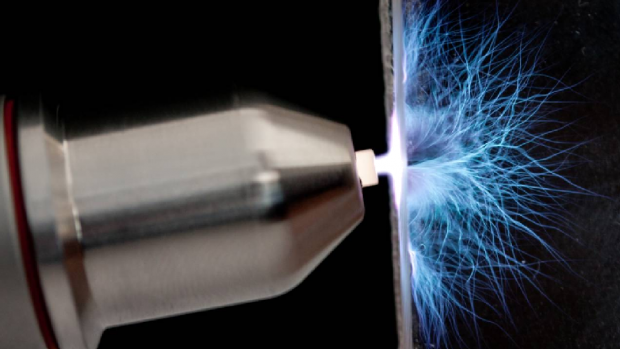Vice Dean for Research, Innovation, and Entrepreneurship Co-authors Seminal Study on the Future of Plasma Science and Technology

Argon plasma jet penetrating a narrow slit to treat the inner surface of an object.
Kurt Becker, NYU Tandon’s Vice Dean for Research, Innovation, and Entrepreneurship, is among a group of prominent plasma scientists from the U.S., Germany, Poland, the Czech Republic, Italy, Slovenia, Japan, and Australia who published a seminal report on the Future of Plasma Science and Plasma Technology. The study, published in the journal Plasma Processes and Polymers, summarizes the outcomes of two recent workshops attended by more than 100 plasma scientists from almost 20 nations around the globe. The paper assesses the current status of selected high-value plasma-enabled applications, highlights new and emerging technologies that leverage plasmas and identifies the underlying basic science that is needed to support the development and implementation of these new applications.
“Plasmas have addressed important societal problems and have created significant economic impact through the interplay of basic science, applied science, and technological challenges for over 150 years,” Becker explained. “Plasmas play a crucial role in many manufacturing processes, such as microchip fabrication and surface functionalization. Plasma technologies are instrumental in the production of photovoltaic cells and fuel cells for green energy generation, and they mitigate environmental hazards and processes that contribute to climate change.” He continued, “The use of plasmas in medicine, agriculture and for food preservation opens up possibilities in new areas, where plasma technologies were not present until recently.”
 Plasma-based processes revolutionized the micro-/nanoelectronics industry and thus unleashed one of the most important economic driving forces of our generation. Semiconductor sales worldwide are approaching $500 billion. The U.S. Bureau of Labor Statistics estimated in 2015 that there were close to 250,000 jobs in the semiconductor industry and that each of those jobs indirectly supported five more in other parts of the U.S. economy. Semiconductor sales demand is driven by consumer products, mostly communication devices and other “smart” systems. Up to 40% of the process steps in the fabrication of state-of-the art microchips and VLSI/ULSI (very/ultra large scale integration) devices are plasma-based. Placing 30 billion transistors on a substrate the size of a finger nail is only possible because of the unprecedented spatial resolution of plasma processes.
Plasma-based processes revolutionized the micro-/nanoelectronics industry and thus unleashed one of the most important economic driving forces of our generation. Semiconductor sales worldwide are approaching $500 billion. The U.S. Bureau of Labor Statistics estimated in 2015 that there were close to 250,000 jobs in the semiconductor industry and that each of those jobs indirectly supported five more in other parts of the U.S. economy. Semiconductor sales demand is driven by consumer products, mostly communication devices and other “smart” systems. Up to 40% of the process steps in the fabrication of state-of-the art microchips and VLSI/ULSI (very/ultra large scale integration) devices are plasma-based. Placing 30 billion transistors on a substrate the size of a finger nail is only possible because of the unprecedented spatial resolution of plasma processes.
Since plasma technologies are primarily enabling technologies, their contribution to a specific product or method remains often hidden or even unknown and their direct impact, especially their economic impact, is often difficult to assess.
The published study highlights several areas of high‐value applications of significant societal and economic impact where future progress depends critically on further advances in basic and applied plasma science and technology such as (1) Energy and Power, (2) Optics and Glasses, (3) Aerospace and Automotive, (4) Plastics and Textiles, (5) Environment, and (6) Medicine and Hygiene. For each area, an assessment is made of the state-of-the art, of the established technology potential, and, when possible, success stories are presented along with a market share study. Area‐specific solutions are presented and emerging and potentially new applications are highlighted. Research needs required to advance these technologies are identified. This is of particular significance as the rapid development of plasma applications has often occurred by trial‐and‐error, i.e. without having a good understanding of the underlying basic science.
The intended audiences for this study are not primarily scientists and engineers, but rather the general public and decision makers in politics and industry, who — among other things — have the responsibility to identify and set priorities for future research funding.
Read the Study
On the Board
In recognition of his experience, wisdom, and leadership in the field of low-temperature plasma physics and applications, Becker was recently appointed to the Editorial Board of Physics of Plasmas, the leading journal in plasma physics in the U.S. He will serve a three-year term starting in January 2019, helping to ensure the continued high caliber of the journal and expanding its visibility beyond the U.S.




